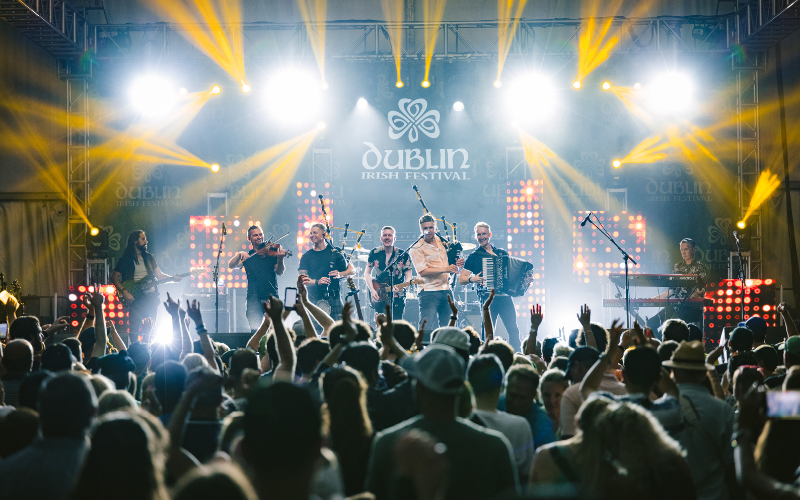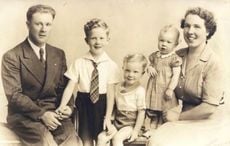This week the town of Tullamore will be abuzz with traditional Irish music as one of the largest gathering of traditional Irish musicians and students descend upon the Offaly town.
With the convening of Scoil Eigse and Fleadh Cheoil na hEireann, the annual Comhaltas Ceoltoiri Eireann event that may draw over 200,000 tradheads to the Midlands in one of the largest cultural displays in Ireland, the focus will be on the musicians living and deceased who are credited with making all this magic happen year after year.
One of the most storied musicians in the entire history of trad music, Paddy O’Brien, will certainly be remembered through many of his compositions as the tunes are taught, learned and shared over the week-long celebration.
And earlier this summer with the release of a new publication, The Definitive Collection of the Music of Paddy O’Brien 1922-1991, launched at both the Willie Clancy Summer School and the Catskills Irish Arts Week by his daughter Eileen O’Brien Minogue who edited it and compiled it, the importance of a musician like Paddy O’Brien was brought home anew to the Irish music community worldwide.
No ordinary compendium of tunes from the iconic box player from Newtown, Co. Tipperary is this 212-page opus produced by his fiddle-playing daughter, Eileen as a byproduct of her research in garnering a master’s degree at the Irish World Music Center at the University of Limerick.
Recognizing the extraordinary legacy of music she and her brother Donnchadh inherited through both the O’Brien and Seery families of their parents Paddy and Eileen, Eileen Og went well beyond the 1992 publication of the earlier collection of O’Brien compositions that came out a year after his death at the age of 69 in 1991. The Arts Council of Ireland helped to fund the new collection that was more than just a labor of love and precision.
The latest collection contains all 100 compositions of the master accordion player who revolutionized the B/C button box back in the 1950s and is generally considered one of the giants in Irish traditional music lore.
In addition, we are presented with a good number of arrangements and settings of popular Irish traditional music tunes that have come to be associated with Paddy O’Brien’s playing or given extra lift and drive through his talented hands.
Whether people heard his early 78 recordings, radio and television broadcasts, live performances at fleadhanna, feisianna, ceili dances, house parties or pub sessions and music classes, the reaction was always the same -- no one could bring as much to Irish music on the two-row B/C accordion like Paddy O’Brien from Nenagh, Co. Tipperary.
As a highly regarded musician and teacher herself, Eileen Og O’Brien goes beyond just boasting about the family musical inheritance, and her father’s prowess in this work as its extra-added value is to see how so many others viewed the impact of Paddy O’Brien’s music on themselves and its overall evolution.
Laced among all the compositions, arrangements and music notes -- which alone are invaluable for any serious Irish musician or student -- are the collected thoughts and assessments of his peers that help provide a fuller picture of the man who brought accordion playing on a par with the flute, fiddle and pipes in the mainstream of Irish traditional music.
The careful and comprehensive use of other voices to help describe how O’Brien came to be one of the most respected and innovative musicians ever in Irish music makes for marvelous reading for those who can’t read the “dots” and music in giving a feel for a man who gave so much to keep the tradition alive.
In an earlier era, Sligo musicians Michael Coleman and James Morrison took advantage of the nascent recording industry to perpetuate Irish fiddle playing, particularly as it might have originated in their home county and migrated to New York.
In a slightly different way, O’Brien from Nenagh was the right man to come along at the right time in the traditional music timeline. Blessed with perfect pitch, the mechanical genius to figure out how to get more notes out of an accordion for a smoother blend with the flutes and fiddles more prevalent in Irish music and a perfectionist approach that he applied to traditional music, he was destined for greatness.
His métier was bringing innovation from within the music and not from outside which, again, was very important at that historical juncture, and especially for the development of the button box accordion from then onwards inspiring so many great players like Joe Burke and Martin Mulhaire to name but a couple.
Reared in a household where the fireside music was revered and played with heart and soul -- which always characterized the music of his highly regarded father Dinny O’Brien who taught Paddy the fiddle first -- Paddy had the skill set to leave all of that in the music while adding extraordinary technique and dexterity to the box.
As CCE was on their mission to promote fleadhs across Ireland which helped raise the standard of music and also introduced musicians to one another who may have never met before, a new brotherhood (and sisterhood) was emerging.
That solidarity was enhanced by technological improvement and tools in the recording field leading to long playing (LP) records and tape machines and more affordable availability fueled still by the need for immigration to England or America because the times were still so severe in Ireland.
But that mobility was becoming more of an asset as two-way travel became more economical and long-distance musical conversation and transmission became more the norm.
So like many others Paddy O’Brien had to immigrate to New York to make a living, but since traditional music was such an ingrained part of his life and a passion that could not be denied, he quickly fell in with the right crowd in New York and continued to blaze a pioneering trail on the B/C box.
Paddy only spent eight years in New York while marrying his sweetheart Eileen Seery from Dublin (whom he met at a fleadh) and starting a family with the birth of Eileen Og in New York before returning to Ireland in 1962.
With experience in both the Aughrim Slopes and Tulla Ceili Bands before leaving Ireland, he helped formulate the New York Ceili Band which captured a third place in the senior ceili band All-Ireland competition in Boyle, Co. Roscommon in 1960.
He would later taste the sweetness of an All-Ireland championship not once but four times with the Ormond Ceili Band (1979-1980-1981 for the three-peat and again in 1984) along with daughter Eileen. But he also trained a number of very successful musicians who achieved greatness on their own under his careful tutelage.
After returning to Ireland he formed one of the seminal music tandems in Irish music history with fiddler Seamus Connolly, who was born in Killaloe across the Shannon, who was in awe of O’Brien’s music from an early age. They became close friends as well as musical partners who brought out even greater things in each other as a result.
Ironically their one recording together, On the Banks of the Shannon, was a short album accompanied by Leitrim’s Charlie Lennon on piano and produced by CCE was both a defining and disappointing moment.
Deemed as one of the more important albums in the Irish music canon because of the duet playing of Connolly and O’Brien that captivated listeners, it could have been a greater success but less than desirable engineering flaws plagued the project hastily done in a Dublin studio in less than two hours.
The opportunity to revisit some of that magic with Seamus Connolly and Eileen O’Brien this summer once again reinforced the living tradition and paid homage to one of true giants in Irish music.
Copies of the new book sold out the first night on the eve of Eileen’s lecture on the project in the Weldon House in East Durham, but it can be ordered through www.paddyobrienbook.com. You can have an autographed copy by Eileen og O’Brien in your music library. It is a fascinating and must read for all fans of traditional Irish music.
Sean-Nos Lessons
ONE of the American step dancers in the vanguard of the sean-nos step dancing phenomenon that is very popular in Ireland these days, Maldon Meehan from Portland, Oregon will be stopping in New York to give an evening workshop on Friday, August 21 from 7 -10 p.m.
Sean-nos step dancing is a form of percussive solo dancing that we tend to associate with Connemara, though it is done all over Ireland as workshops, competitions and festival appearances abound with a keen interest especially among young people. Meehan is an 18- year dancing veteran who has studied the current revival in Ireland including obtaining a master’s degree at the Irish World Music Center at the University of Limerick.
Beginners can shuffle to the Pearl Studios (500 Eighth Avenue) in Room 407 from 7-8:30 pm followed by a workshop for more experienced dancers from 8:30-10 p.m. Fee for one class is $20 and $30 for both. Hosting these classes are Anna Piliszek and Kate Foster. Contact [email protected] or www.seannosnyc.blogspot.com. For more information on Maldon Meehan you can visit her website www.maldonmeehan.com.




Comments